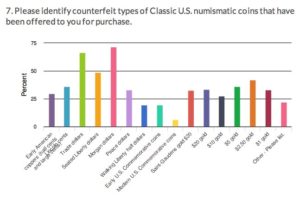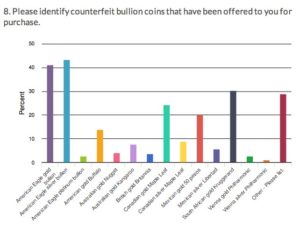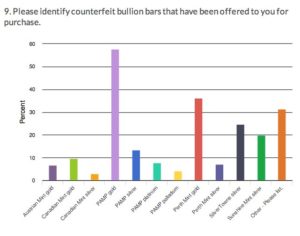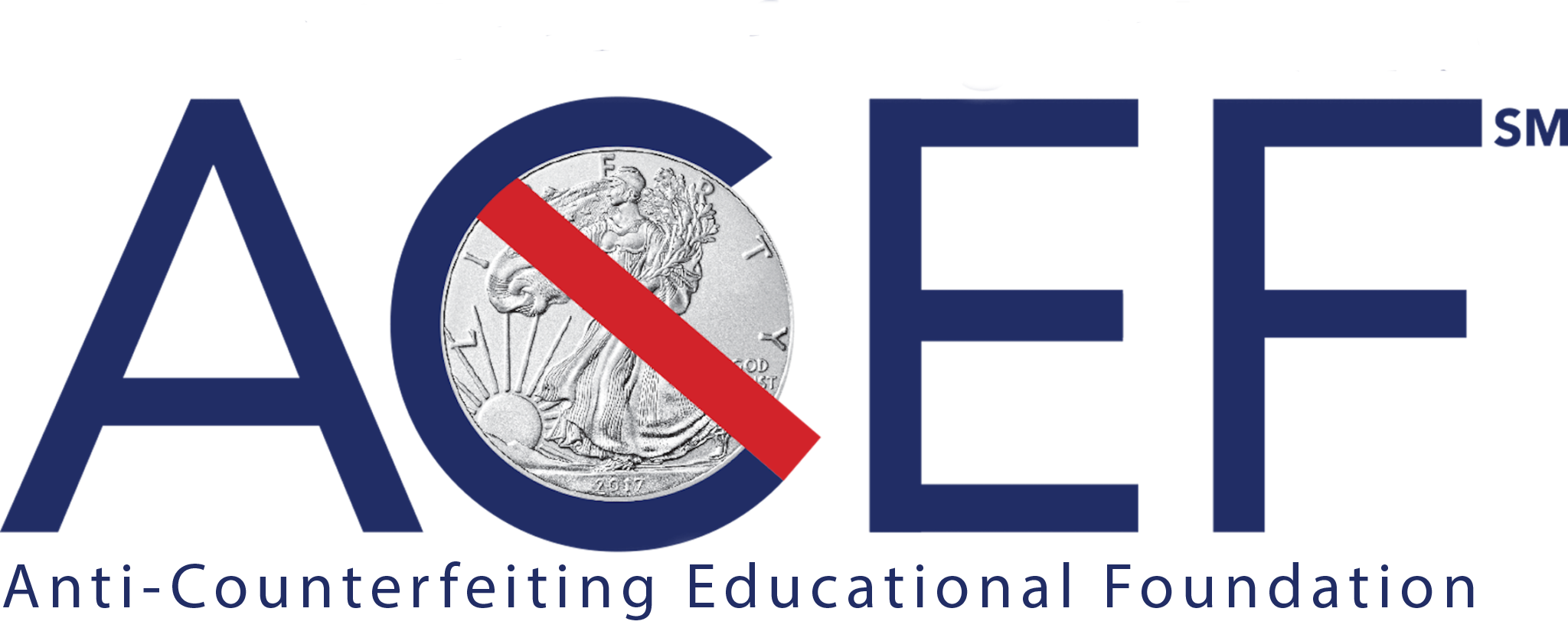
Hints: Fakes are known of every U.S. coin design type produced by the United States Mint since 1793. Counterfeiters target bullion coins, bars, and holders with the highest brand identity.
Would you be surprised to learn that all the coins, bars and holders pictured are counterfeit? They are!
Morgan dollar is the most counterfeited U.S. coin
The Morgan silver dollar is the most frequently counterfeited U.S. coin, according to coin dealers responding to a survey conducted by the Anti-Counterfeiting Task Force in June 2018.
 The popular Morgan dollar led the field of frequently encountered counterfeits at 71.7 percent, followed by Trade dollars, 66.6 percent; Seated Liberty dollars, 48.6 percent; Lincoln cents, 35.9 percent; Peace dollars, 33.1 percent; and Early American copper large cents and half cents, 29.7 percent.
The popular Morgan dollar led the field of frequently encountered counterfeits at 71.7 percent, followed by Trade dollars, 66.6 percent; Seated Liberty dollars, 48.6 percent; Lincoln cents, 35.9 percent; Peace dollars, 33.1 percent; and Early American copper large cents and half cents, 29.7 percent.
Among collector gold U.S. coins, 42. 1 percent of the dealers reported counterfeits of the $2.50 gold coin are the most frequently encountered, followed by fakes of $5 gold, 36.2 percent; $20 gold, 33.4 percent; $1 gold, 33.1 percent; and $10 gold, 27.6 percent.
In the bullion coin category U.S. silver and gold American Eagle bullion coins top the list of most frequently encountered fakes.
 Some 43.3 percent of coin dealers in the United States report encountering customers seeking to sell them counterfeit silver American Eagle bullion coins. Similarly, 41.2 percent report customers trying to sell them fake gold American Eagle bullion coins. Fake foreign gold bullion coins encountered include the South African gold Krugerrand at 30.4 percent, the Canadian gold Maple Leaf at 24.2 percent, and Mexican gold 50 pesos at 20.1 % percent.
Some 43.3 percent of coin dealers in the United States report encountering customers seeking to sell them counterfeit silver American Eagle bullion coins. Similarly, 41.2 percent report customers trying to sell them fake gold American Eagle bullion coins. Fake foreign gold bullion coins encountered include the South African gold Krugerrand at 30.4 percent, the Canadian gold Maple Leaf at 24.2 percent, and Mexican gold 50 pesos at 20.1 % percent.
“The survey results are not surprising to us,” said Beth Deisher, ACEF Director of Anti-Counterfeiting. “Counterfeiters — primarily from China — target the most popular products, usually market leaders with the highest brand identification.”
She cited survey results in one other category, bullion bars.
 PAMP (Suisse) gold ingots and bars are the worldwide market leader; 57.8 percent of U.S. dealers in the survey reported customers seeking to sell them counterfeit gold PAMP bars and 36.1 percent reported encountering fakes of Australia’s Perth Mint gold bars. For silver, fakes of privately minted bars bearing the logos of the SilverTowne Mint, 24.7 percent, and the private Sunshine Mint (19.9 percent) registered highest in the survey.
PAMP (Suisse) gold ingots and bars are the worldwide market leader; 57.8 percent of U.S. dealers in the survey reported customers seeking to sell them counterfeit gold PAMP bars and 36.1 percent reported encountering fakes of Australia’s Perth Mint gold bars. For silver, fakes of privately minted bars bearing the logos of the SilverTowne Mint, 24.7 percent, and the private Sunshine Mint (19.9 percent) registered highest in the survey.
According to the survey, 92.4 percent of respondents said they rely on their personal knowledge of coins and bars to identify fakes and 60.6 percent use counterfeit detecting equipment to verify their suspicions. Some 41.4 percent report having completed counterfeit detection classes with the remainder having attended seminars or educational presentations detailing deceptive counterfeits in the marketplace.
More than 80 percent of the survey participants noted an increase in the number of counterfeit coins and bars entering the marketplace during the past five years.
Had the counterfeits they have encountered in the past year been genuine, 28.8 percent estimated the value would have been between $1,000 to $5,000 with 8.4 percent estimating the value at more than $300,000. More than 50 of the respondents place the value between $5,000 and $300,000.
More than 68 percent of the dealer respondents reported encountering counterfeits sporadically over weeks and months, while 9.2 percent reported being offered them two to three times a week and 1.9 percent being offered them daily.
The online survey of dealer members of the Industry Council for Tangible Assets, the Professional Numismatist Guild, and the American Numismatic Association was conducted June 7 through 14, 2018, by the Research Work Group of the Anti-Counterfeiting Task Force.
